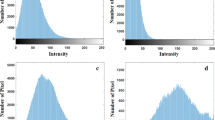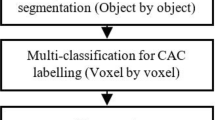Abstract
Detection of different classes of atherosclerotic plaques is important for early intervention of coronary artery diseases. However, previous methods focused either on the detection of a specific class of coronary plaques or on the distinction between plaques and normal arteries, neglecting the classification of different classes of plaques. Therefore, we proposed an automatic multi-class coronary atherosclerosis plaque detection and classification framework. Firstly, we retrieved the transverse cross sections along centerlines from the computed tomography angiography. Secondly, we extracted the region of interests based on coarse segmentation. Thirdly, we extracted a random radius symmetry (RRS) feature vector, which incorporates multiple descriptions into a random strategy and greatly augments the training data. Finally, we fed the RRS feature vector into the multi-class coronary plaque classifier. In experiments, we compared our proposed framework with other methods on the cross sections of Rotterdam Coronary Datasets, including 729 non-calcified plaques, 511 calcified plaques, and 546 mixed plaques. Our RRS with support vector machine outperforms the intensity feature vector and the random forest classifier, with the average precision of 92.6 ± 1.9% and average recall of 94.3 ± 2.1%. The proposed framework provides a computer-aided diagnostic method for multi-class plaque detection and classification.

Diagram of the proposed automatic multi-class coronary atherosclerosis plaque detection and classification framework.
ᅟ







Similar content being viewed by others
References
Acharya UR, Mookiah MRK, Sree SV, Afonso D, Sanches J, Shafique S, Nicolaides A, Pedro LM, Fernandes e Fernandes J, Suri JS (2013) Atherosclerotic plaque tissue characterization in 2D ultrasound longitudinal carotid scans for automated classification: a paradigm for stroke risk assessment. Med Biol Eng Comput 51: 513–523 Doi https://doi.org/10.1007/s11517-012-1019-0
Austen WG, Edwards JE, Frye RL, Gensini GG, Gott VL, Griffith LS, McGoon DC, Murphy ML, Roe BB (1975) A reporting system on patients evaluated for coronary artery disease. Report of the Ad Hoc Committee for Grading of Coronary Artery Disease, Council on Cardiovascular Surgery, American Heart Association. Circulation 51:5–40
Chen Y, Zhang Y, Yang J, Cao Q, Yang G, Chen J, Shu H, Luo L, Coatrieux J-L, Feng Q (2016) Curve-like structure extraction using minimal path propagation with backtracking. IEEE Trans Image Process 25:988–1003. https://doi.org/10.1109/tip.2015.2496279
Cruz-Aceves I, Hernandez-Aguirre A, Ivvan Valdez S (2016) On the performance of nature inspired algorithms for the automatic segmentation of coronary arteries using Gaussian matched filters. Appl Soft Comput 46:665–676. https://doi.org/10.1016/j.asoc.2016.01.030
Dalager MG, Bottcher M, Thygesen J, Andersen G, Botker HE (2015) Different plaque composition and progression in patients with stable and unstable coronary syndromes evaluated by cardiac CT. Biomed Res Int 2015:401357–401359. https://doi.org/10.1155/2015/401357
de Graaf MA, Broersen A, Kitslaar PH, Roos CJ, Dijkstra J, Lelieveldt BPF, Jukema JW, Schalij MJ, Delgado V, Bax JJet al (2013) Automatic quantification and characterization of coronary atherosclerosis with computed tomography coronary angiography: cross-correlation with intravascular ultrasound virtual histology. Int J Cardiovasc Imaging 29: 1177–1190 Doi https://doi.org/10.1007/s10554-013-0194-x
Dey D, Cheng VY, Slomka PJ, Nakazato R, Ramesh A, Gurudevan S, Germano G, Berman DS (2009) Automated 3-dimensional quantification of noncalcified and calcified coronary plaque from coronary CT angiography. J Cardiovasc Comput Tomogr 3:372–382. https://doi.org/10.1016/j.jcct.2009.09.004
Dhanaseelan R, Jeya Sutha M (2017) Diagnosis of coronary artery disease using an efficient hash table based closed frequent itemsets mining. Med Biol Eng Comput 56:749–759. https://doi.org/10.1007/s11517-017-1719-6
Fuchs TA, Fiechter M, Gebhard C, Stehli J, Ghadri JR, Kazakauskaite E, Herzog BA, Husmann L, Gaemperli O, Kaufmann PA (2013) CT coronary angiography: impact of adapted statistical iterative reconstruction (ASIR) on coronary stenosis and plaque composition analysis. Int J Cardiovasc Imaging 29:719–724. https://doi.org/10.1007/s10554-012-0134-1
Guaricci AI, Pontone G, Brunetti ND, De Rosa F, Montrone D, Guglielmo M, Mushtaq S, Fusini L, Maffei E, Cademartiri Fet al (2016) The presence of remodeled and mixed atherosclerotic plaques at coronary ct angiography predicts major cardiac adverse events—the CAFE-PIE Study. Int J Cardiol 215: 325–331 Doi https://doi.org/10.1016/j.ijcard.2016.04.129
Hernandez-Vela A, Gatta C, Escalera S, Igual L, Martin-Yuste V, Sabate M, Radeva P (2012) Accurate coronary centerline extraction, caliber estimation, and catheter detection in angiographies. IEEE Trans Inf Technol Biomed 16:1332–1340. https://doi.org/10.1109/titb.2012.2220781
Kang D, Slomka PJ, Nakazato R, Arsanjani R, Cheng VY, Min JK, Li D, Berman DS, Kuo CCJ, Dey D (2013) Automated knowledge-based detection of nonobstructive and obstructive arterial lesions from coronary CT angiography. Medical Physics 40:40. https://doi.org/10.1118/1.4794480
Kelm BM, Mittal S, Zheng Y, Tsymbal A, Bernhardt D, Vega-Higuera F, Zhou SK, Meer P, Comaniciu D (2011) Detection, grading and classification of coronary stenoses in computed tomography angiography.In: Fichtinger G., Martel A., Peters T. (eds) Medical Image Computing and Computer-Assisted Intervention – MICCAI 2011. Lect Notes Comput Sc, 6893: 25-32.
Kirisli HA, Schaap M, Metz CT, Dharampal AS, Meijboom WB, Papadopoulou SL, Dedic A, Nieman K, de Graaf MA, Meijs MFLet al (2013) Standardized evaluation framework for evaluating coronary artery stenosis detection, stenosis quantification and lumen segmentation algorithms in computed tomography angiography. Med Image Anal 17: 859–876 Doi https://doi.org/10.1016/j.media.2013.05.007
Lee W, Choi GJ, Cho SW (2017) Numerical study to indicate the vulnerability of plaques using an idealized 2D plaque model based on plaque classification in the human coronary artery. Med Biol Eng Comput 55:1379–1387. https://doi.org/10.1007/s11517-016-1602-x
Li C, Xu C, Gui C, Fox MD (2010) Distance regularized level set evolution and its application to image segmentation. IEEE Trans Image Process 19:3243–3254. https://doi.org/10.1109/tip.2010.2069690
Mahapatra D (2017) Semi-supervised learning and graph cuts for consensus based medical image segmentation. Pattern Recogn 63:700–709. https://doi.org/10.1016/j.patcog.2016.09.030
Mahapatra D, Schuffler PJ, Tielbeek JAW, Makanyanga JC, Stoker J, Taylor SA, Vos FM, Buhmann JM (2013) Automatic detection and segmentation of Crohn’s disease tissues from abdominal MRI. IEEE Trans Med Imaging 32:2332–2347. https://doi.org/10.1109/tmi.2013.2282124
Renard F, Yongyi Y (2008) Image analysis for detection of coronary artery soft plaques in MDCT images. 5th IEEE International Symposium on Biomedical Imaging: From Nano to Macro, City, pp 25-28
Rinck D, Krüger S, Reimann A, Scheuering M (2006) Shape-based segmentation and visualization techniques for evaluation of atherosclerotic plaques in coronary artery disease. SPIE, City, pp 61410G
Roger VL, Go AS, Lloyd-Jones DM, Benjamin EJ, Berry JD, Borden WB, Bravata DM, Dai S, Ford ES, Fox CSet al (2012) Heart disease and stroke statistics—2012 update a report from the American Heart Association. Circulation 125: E2-E220 Doi https://doi.org/10.1161/CIR.0b013e31823ac046
Rubin GD, Leipsic J, Schoepf UJ, Fleischmann D, Napel S (2014) CT angiography after 20 years: a transformation in cardiovascular disease characterization continues to advance. Radiology 271:633–652. https://doi.org/10.1148/radiol.14132232
Takaoka H, Funabashi N, Ozawa K, Kobayashi Y (2013) Co-existing multiple vulnerable plaque characteristic factors in single non-obstructive non calcified or mixed plaques in coronary arteries on CT could predict occurrence of major cardiac events on follow-up for a median of 103 months. Circulation 128:11225
Takaoka H, Funabashi N, Uehara M, Ozawa K, Kobayashi Y (2013) Number of vulnerable plaque characteristics that are required in a single non-calcified plaque on CT to be at high risk of causing major adverse cardiovascular events. J Am Coll Cardiol 61:E1157. https://doi.org/10.1016/s0735-1097(13)61157-2
Tessmann M, Vega-Higuera F, Fritz D, Scheuering M, Greiner G (2009) Multi-scale feature extraction for learning-based classification of coronary artery stenosis. SPIE, City, pp 726002
Toumoulin C, Boldak C, Garreau M, Boulmier D (2003) Coronary characterization in multi-slice computed tomography. Computers in Cardiology, City, pp 749–752
Valencia MAZ (2011) Methods for automation of vascular lesions detection in computed tomography images. Universidad de los Andes, City
Wang Y, Liatsis P (2009) A fully automated framework for segmentation and stenosis quantification of coronary arteries in 3D CTA imaging. 2009 Second International Conference on Developments in eSystems Engineering, City, pp 136-140
Wesarg S, Khan MF, Firle EA (2006) Localizing calcifications in cardiac CT data sets using a new vessel segmentation approach. J Digit Imaging 19:249–257. https://doi.org/10.1007/s10278-006-9947-6
Yang G, Kitslaar P, Frenay M, Broersen A, Boogers MJ, Bax JJ, Reiber JHC, Dijkstra J (2012) Automatic centerline extraction of coronary arteries in coronary computed tomographic angiography. Int J Cardiovasc Imaging 28:921–933. https://doi.org/10.1007/s10554-011-9894-2
Zhang J, Zhao H, Liang J (2013) Continuous rotation invariant local descriptors for texton dictionary-based texture classification. Comput Vis Image Underst 117:56–75. https://doi.org/10.1016/j.cviu.2012.10.004
Zhao F, Liang J, Chen X, Liu J, Chen D, Yang X, Tian J (2016) Quantitative analysis of vascular parameters for micro-CT imaging of vascular networks with multi-resolution. Med Biol Eng Comput 54:511–524. https://doi.org/10.1007/s11517-015-1337-0
Zhao F, Liu J, Qu X, Xu X, Chen X, Yang X, Cao F, Liang J, Tian J (2014) In vivo quantitative evaluation of vascular parameters for angiogenesis based on sparse principal component analysis and aggregated boosted trees. Phys Med Biol 59:7777–7791. https://doi.org/10.1088/0031-9155/59/24/7777
Zuluaga MA, Magnin IE, Hernandez Hoyos M, Delgado Leyton EJF, Lozano F, Orkisz M (2011) Automatic detection of abnormal vascular cross-sections based on density level detection and support vector machines. Int J Comput Assist Radiol Surg 6:163–174. https://doi.org/10.1007/s11548-010-0494-8
Acknowledgements
The authors also would like to thank Dr. Muhan Liu for his assistance in polishing the manuscript.
Funding
This work was partly supported by the National Key R&D Program of China under Grant No. 2016YFC1300300; the National Natural Science Foundation of China under Grant Nos. 61601363, 61701403, 61401264, 11571012, 81530058; the Natural Science Research Plan Program in Shaanxi Province of China under Grant Nos. 2017JQ6017, 2017JQ6006, 2015JM6322, and 2015JZ019; and the Scientific Research Foundation of Northwest University.
Author information
Authors and Affiliations
Corresponding authors
Ethics declarations
Conflict of interest
The authors declare that they have no conflict of interest.
Ethical approval
All the CTA data are obtained from public database. No human/animal experiments are involved in this paper.
Rights and permissions
About this article
Cite this article
Zhao, F., Wu, B., Chen, F. et al. An automatic multi-class coronary atherosclerosis plaque detection and classification framework. Med Biol Eng Comput 57, 245–257 (2019). https://doi.org/10.1007/s11517-018-1880-6
Received:
Accepted:
Published:
Issue Date:
DOI: https://doi.org/10.1007/s11517-018-1880-6




